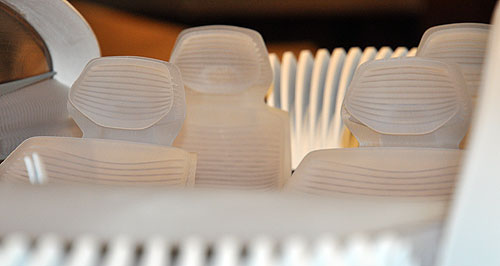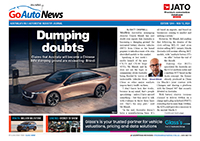Make / Model Search
News - General News - PeopleVACC Design Awards’ wheel-less winnerDesigns on winning: Merric French won the top award for a tertiary student with his shape-shifting interior. Winners announced last night at the VACC Automotive Design Awards in Melbourne27 Jun 2014 By IAN PORTER The winner of the 2014 VACC Automotive Design Awards really stood out from the rest of the entries. It didn’t have any wheels. The winning designer, Merric French, did not design a supercar or a multi-modal transport solution, instead, he explored the possibilities that new materials would present to designers in coming years. His winning entry was a shape-shifting interior made possible by a number of miraculous new materials, some not even on the market yet, which enable a designer to completely transform the traditional idea of what a vehicle interior can be. After spending 14 months completing a design internship at Ford Australia, Mr French went back to Monash University to complete his final year, but he wasn’t about to simply repeat what others had done before. “In the final year, you need to do a lot of research,” he told GoAuto after lifting the $4000 first prize. “I spent quite a few weeks looking into new materials which I didn’t know even existed.” “The idea spawned from that reading. Suddenly I was given the opportunity to design with a material that could change shape, it could be programmed, adapt to your body temperature, change colour and even go transparent.” In fact, there’s more than one exciting new material to experiment with. “There are smart memory alloys and smart memory polymers. Each do a different job and, depending on their physical makeup, they can be programmed for different things.” And it’s more than just changing shape or attitude between the first driver and the second driver, like the current style of memory seat with electric motors. “It goes further than that because the interior is using autonomous technology so it can actually detect your needs inside the car.”  Left: 2014 VACC Automotive Design Awards winner Merric French. Left: 2014 VACC Automotive Design Awards winner Merric French.He said the flexible interiors that will be possible in the future would not only be well suited to autonomous vehicles, where there is no need for a driver and no need for the traditional seat layout. Mr French said flexible interiors would also be able to accommodate disabled people, giving them the transportation freedom often denied to them. “There’s not really an opportunity for disabled people to drive normal cars, unless you buy a car and fit it with levers and cranks. It’s crap. “So I really wanted to target that, get something that’s more organic and something that can apply to everyone.” It offers all sorts of flexibility to all drivers, he said. “Say you want to drive in the middle of the car, like a McLaren. You can do it. “Or if you are driving home from work and you are tired, you can just turn the car into autonomous mode and make it take you home.“The reason the model did not have wheels is because Mr French believes the flexible interior could be applied to many types of transport. “You could put this technology on an aircraft, on a train, on a boat, it doesn’t matter. “That’s why my model doesn’t have wheels. Because it’s a context. It’s a thing that could slot in anywhere. “For me it’s the start of a conversation about where we can take these future materials and where they will take us.” Mr Merric has not been able to get back in to automotive design, and is currently freelancing as a creative designer, a role that has taken him in unexpected directions. “My first job was for Aesop, the skin care company. I did their latest campaign, which required thousands of noses to create Aesop’s Nasotheque in the Myer windows. “So my business partner and I worked out a way of casting a lot of people’s noses but also producing noses that were 450mm high and a metre high. “And they looked perfect because Aesop is really clinical about what they do. It’s only the best stuff. Nothing but the best for them.” But Mr French’s automotive dream is not dead. “I would love to go overseas and work in the automotive industry.” The main prize for a secondary student, and $2000, went to Aman Bhatti of Lavalla Catholic College, Traralgon. The prize money awarded to the top three in each category is duplicated for the educational institution they attended. As part of the design awards, Ford Australia also offers two secondary students a two-week internship at its Broadmeadows design centre. This year, one of the 2013 winners, Aman Bhatti, was invited to do a second stint. The other student who will receive an internship is Alexander Holmes. The judges for the design awards were led by chairman of the judging panel, Paul Beranger, who formerly headed the Toyota Style Australia design studio in Melbourne. The panel included Richard Ferlazzo, design director at GM-Holden, Andy Collinson, head of exterior design at Ford Australia and Nic Hogios, who now heads Toyota Style Australia.  Read more |
Click to shareGeneral News articlesResearch General News Motor industry news |











Facebook Twitter Instagram